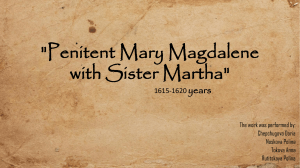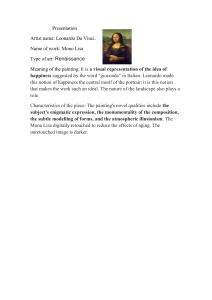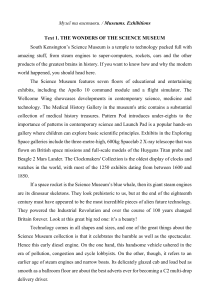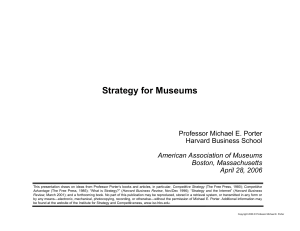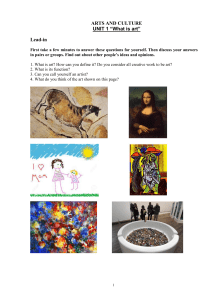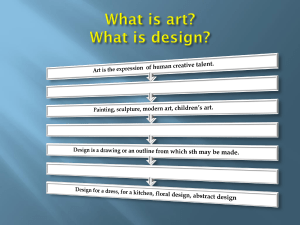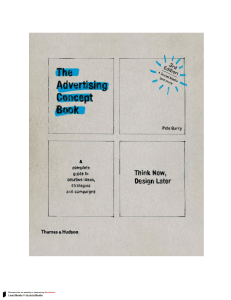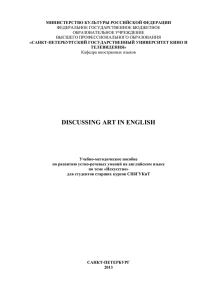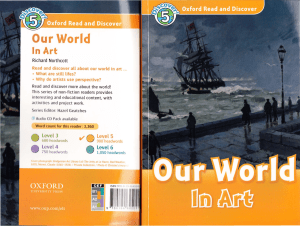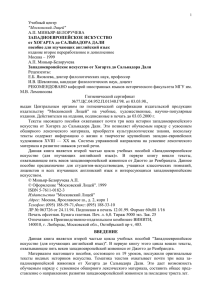скачать/просмотреть - кафедра иностранных языков
advertisement
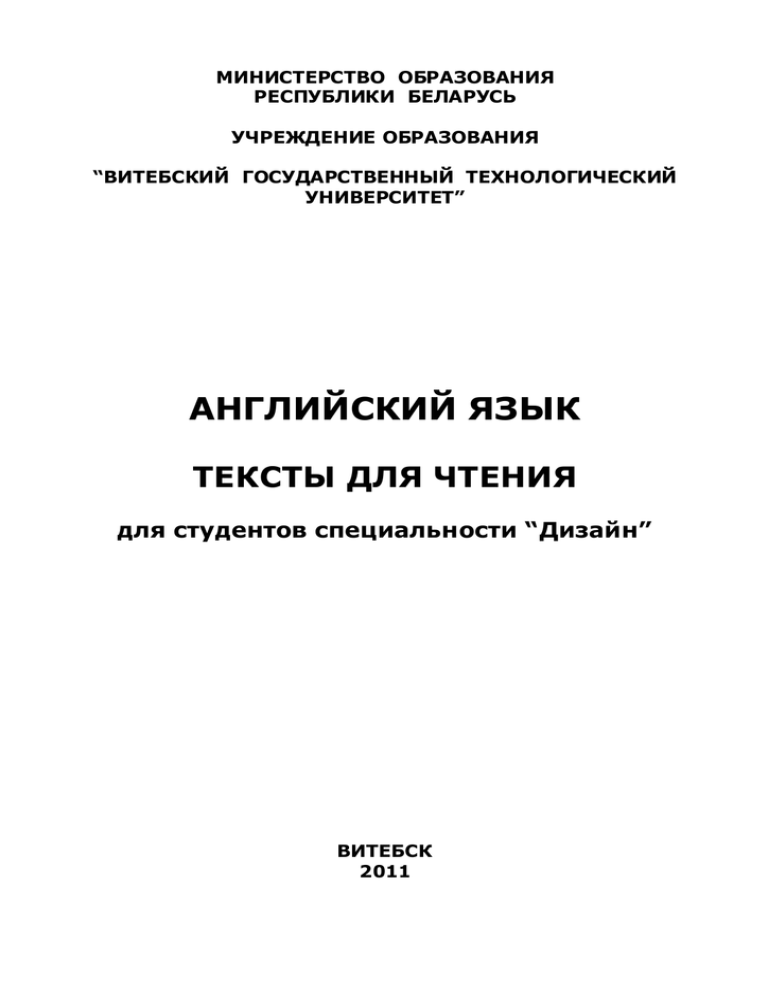
МИНИСТЕРСТВО ОБРАЗОВАНИЯ РЕСПУБЛИКИ БЕЛАРУСЬ УЧРЕЖДЕНИЕ ОБРАЗОВАНИЯ “ВИТЕБСКИЙ ГОСУДАРСТВЕННЫЙ ТЕХНОЛОГИЧЕСКИЙ УНИВЕРСИТЕТ” АНГЛИЙСКИЙ ЯЗЫК ТЕКСТЫ ДЛЯ ЧТЕНИЯ для студентов специальности “Дизайн” ВИТЕБСК 2011 УДК 811.111 (07) Английский язык. Тексты для чтения для студентов специальности “Дизайн”. Витебск: Министерство образования Республики Беларусь, УО “ВГТУ”, 2010. Составители: преп. Бурдыко О.В., ст. преп. Имперович В.В. Настоящие тексты для чтения предназначены для студентов, обучающихся по специальности “Дизайн”. В разработку включены оригинальные английские тексты для чтения и пересказа, а также тексты для самостоятельного чтения по специальности. Одобрено кафедрой иностранных языков УО “ВГТУ” 18 ноября 2010 года, протокол № 6 Рецензент: ст. преп. Яснова Н.П. Редактор: ст. преп. Дырко Н.В. Рекомендовано к опубликованию редакционно-издательским советом УО “ВГТУ” “____”___________ 2010 г., протокол № _____ Ответственная за выпуск: Старцева Л.Н. Учреждение образования “Витебский государственный технологический университет” Подписано к печати _____________ Формат ___________ Уч.-изд. лист. ______ Печать ризографическая. Тираж ________ экз. Заказ № _______ Цена _______ Отпечатано на ризографе учреждения образования государственный технологический университет”. Лицензия № 02330/0494384 от 16 марта 2009 года. 210035, г. Витебск, Московский проспект, 72. 2 “Витебский СОДЕРЖАНИЕ 1 MUSEUM ……………………………………………………………………… 4 2 KINDS OF MUSEUMS (PART I ) ………………………………………….. 3 KINDS OF MUSEUMS (PART II) …………………………………….…… 6 4 FUNCTIONS OF MUSEUMS ……………………………………………….. 7 5 DESIGN ………………………………………………………………………... 9 6 ALBRECHT DURER …………………………………………………………. 10 7 LANDSCAPE PAINTING ……………………………………………………. 12 8 CRAFT OF PAINTING LANDSCAPE PAINTING ……………………….. 14 9 THE ARTIST'S TRAINING ………………………………………………….. 16 5 10 DIGITAL PRINTING …………………………………………………………. 18 11 DIGITAL PAINTING ………………………………………………………… 20 12 PRINTMAKING TECHNIQUES …………………………………………….. 21 13 GRAFFITI ……………………………………………………………………... 23 14 INSTALLATION ART ……………………………………………………….. 25 15 STYLE IN THE ARTS ………………………………………………………. 27 16 EASEL PAINTING: HISTORICAL NOTES (PART I) …………………… 28 17 EASEL PAINTING: HISTORICAL NOTES (PART II) …………………... 30 18 HOW TO APPRECIATE PAINTINGS ……………………………………... 31 19 ON TASTE ……………………………………………………………………. 32 СПИСОК ИСПОЛЬЗУЕМОЙ ЛИТЕРАТУРЫ…………………………………... 33 3 1 MUSEUM GLOSSARY building – здание to display – показывать, выставлять pottery – керамика weapon – оружие to contain – содержать to relate – связывать drawing – рисование main – главный purpose – цель at least – по крайней мере usage – употребление to differ – различаться respect – отношение to use – использовать to show – показывать to imply – значить collection – коллекция, собрание to arrange – устраивать, располагать description – описание partial – частичный, неполный to provide – обеспечивать opportunity – возможность medieval – средневековый onward – идущий вперед to select – отбирать, выбирать decay – распад demolition – разрушение to erect – поднимать, воздвигать entire – полный, целый rural – сельский Museum is in most, but not all-cases, an equivalent of музей, that is, a building in which objects illustrating history, science, culture are displayed. Thus in a museum we expect to find, for example, pottery, weapons, ornaments, furniture, costumes and documents illustrating the life of some past age or period. Specialized museums contain objects relating to a particular sphere of activity, for example, the theatre, musical instruments, railways. A museum may also contain works of art, such as paintings, drawings and sculpture, but that is not generally its main purpose, at least in Britain. American usage differs in this respect, and the expressions art museum, museum of art are used in the USA of a building where works of art are shown. An open-air museum, as its name implies, is not a building, but a collection of exhibits, usually architectural, arranged outside. For example, a brochure about the city of Chichester contains the following description of its open-air museum: “Set in a gently sloping, partially wooded valley, this museum provides a unique opportunity of seeing how country people in southern England lived from medieval times onwards. The main purpose of the museum is to select buildings, threatened by decay or demolition and re-erect them on this 35-acre site. An entire social history of the rural area is demonstrated by the exhibits brought together here.” 4 2 KINDS OF MUSEUMS (PART I) GLOSSARY to preserve – сохранять, охранять to exhibit – выставлять, показывать to display – показывать, выставлять folk – народный to create – создавать to borrow – занимать, заимствовать event – событие to include – включать furniture – мебель tool – инструмент society – общество local – местный certain – определенный crop – урожай to harvest – собирать урожай condition – состояние to restore – восстанавливать to reconstruct – реконструировать to perform – выполнять to print – печатать shoes – обувь There are three main kinds of museums: art museums, history museums, and science museums. Art Museums preserve and exhibit paintings, sculpture, and other works of art. The collections of some art museums include work from many periods. Famous museums of this type include the Louvre in Paris and the Metropolitan Museum of Art in New York City. Some museums specialize in artworks of one period. For example, the Museum of Modern Art in New York City displays works created since the late 1800's. Other museums exhibit only one type of art. The Museum of International Folk Art in Santa Fe, N. Mex., for example, specializes in folk art from around the world. Many art museums also have special exhibits. They borrow works of art from individuals or other museums for such exhibits, which usually last several weeks. History Museums illustrate the life and events of the past. Their collections include documents, furniture, tools, and other materials. Many cities and states have historical societies that operate history museums. Most of these museums have exhibits on local history. Other types of history museums include living history museums. Museums of this type include living history farms, historic houses, and historic villages. These museums show how people lived or worked during a certain period. On living history farms, workers demonstrate how crops were planted and harvested in earlier times. Historic houses, such as Mount Vernon, George Washington's home near Alexandria, Va., have been restored to their original condition and are open to the public. Williamsburg, a historic village in Virginia, has restored and reconstructed buildings that date from the 1700's. In this village, costumed interpreters demonstrate how early colonists performed such tasks as cooking, making shoes, and printing newspapers. 5 3 KINDS OF MUSEUMS (PART II) GLOSSARY science – наука fossil – окаменелость, ископаемой rock – горная порода, камень nature – природа to find – находить dinosaur – динозавр to trace – следить to explain – объяснить field – область tour – экскурсия reproduction – репродукция coal – уголь mine – рудник, шахта to feature – показывать highlights – основной момент wax – воск appropriate – подходящий, соответствующий lifelike – очень похожий setting – окружение, обстановка life-sized – в натуральную величину Science Museums have exhibits on the natural sciences and technology. Museums of natural history exhibit displays of animals, fossils, plants, rocks, and other objects and organisms found in nature. Most of them, including the National Museum of Natural History in Washington, D.C., have exhibits on ecology and the evolution of human beings. Many museums of natural history have special exhibits on dinosaurs and other topics. The exhibits in science-technology museums explain the operations of various types of machines and industrial methods or trace the development of a particular field of technology. Visitors to the Museum of Science and Industry in Chicago can take a guided tour through a realistic reproduction of a coal mine. The National Air and Space Museum in the Smithsonian Institution in Washington, D.C., has exhibits on the history of aviation and space travel. Other Types of Museums feature exhibits on only one subject. The Circus World Museum in Baraboo, Wis., has the world's largest collection of circus wagons. The National Baseball Hall of Fame and Museum in Cooperstown, N.Y., shows highlights of baseball history and displays the uniforms of famous players. Other museums specialize in such subjects as automobiles, clocks, and dolls. Museums that display materials from several fields of study are called general museums. Children's or youth museums have exhibits designed to explain the arts and sciences to young people. A few museums display reproductions or copies of objects. For example, some historical museums have life-sized figures sculptured from wax or plastics. Most of these figures are realistic likenesses of important people in history. The figures are dressed in appropriate costumes and placed in lifelike settings. 6 4 FUNCTIONS OF MUSEUMS GLOSSARY to acquire – приобретать to care – заботиться to provide – обеспечивать service – обслуживание acquisition – приобретение to collect – собирать, коллекционировать item – предмет precious – драгоценный quilt – стеганое одеяло ancestor – предок to fill – заполнять gap – брешь, пробел trip – поездка, путешествие to receive – получать registrar – архивариус description – описание to determine – определять to insure – страховать, застраховывать curator – хранитель (музея) to conduct – руководить wiring – электропроводка to appear – появляться to protect – защищать damage – повреждение lock – замóк to connect – соединять to patrol – охранять device – устройство to publish – публиковать to describe – описывать to furnish – снабжать, предоставлять to determine – определять Museums perform three main functions. These institutions acquire new materials, exhibit and care for materials, and provide various special services. Acquisition of Materials. Every new object that a museum adds to its collection is called an acquisition. Many acquisitions are gifts from people who collect such items as paintings, precious stones, or sculpture. Other gifts include items that have been kept in a family for many generations, such as a quilt or a journal of an ancestor. Sometimes a museum buys an item needed to fill a gap in one of its collections. Museum employees may find new materials on archaeological expeditions or field trips. Museums also borrow materials or entire exhibits from other museums. Acquisitions are received by the museum registrar, a staff member who records the description of each object. Every acquisition is photographed and given a number. Museum officials determine the value of each object and insure it for that amount. Exhibition and Care of Materials. Various members of the museum staff prepare the materials for exhibition. The museum curator may conduct research to learn more 7 about objects. Museum conservators clean, preserve, or restore objects before they are exhibited. The curator decides how materials are displayed. For example, a new object may be added to an existing exhibit or become part of a special exhibit. It may be hung on a wall or placed in a case. Designers plan and create displays. They build cases and furniture for the displays and set up lights and electric wiring. Preparators create display backgrounds and prepare materials for exhibit. Every exhibit receives a label that gives visitors some information about it. Descriptions of all objects appear in the museum's catalog as well. Museums also protect their exhibits from loss or damage. The doors and windows of many museums have alarms in addition to locks. Exhibit cases are locked, and some may be connected to alarms. Guards patrol museums. Museums may use special light bulbs and devices that control humidity and temperature to protect objects from environmental damage. Special Services. Many museums have an education department that gives lectures and classes on the museum's collection. Most museums offer gallery talks, guided tours, and other programs for children and adults. Other activities provided by museums include art festivals, concerts, and hobby workshops. Many museums publish bulletins and pamphlets that describe current and future exhibits. Museums also furnish scholars with research materials and the use of special laboratories and libraries. Evaluation specialists determine how well the museum meets the educational needs of the public. Some museums serve as places where local artists can exhibit their work. 8 5 DESIGN GLOSSARY arrangement – расположение to satisfy – удовлетворять, соответствовать purpose – цель, назначение creation – создание line – линия, черта plane – плоскость, проекция texture – структура, строение colour – цвет shape – форма, очертание volume – объем space – пространство variety – разнообразие overall – полный, общий repetition – повторение reflection – отражение to obtain – получать, достигать pleasing – приятный, нравящийся to equal – равняться opposite – противоположность to involve – включать в себя relationship – отношение, связь dense – плотный, частый, густой sparse – редкий, разбросанный scattered – разбросанный, разрозненный concentrated – сосредоточенный static – неподвижный, стационарный pattern – образец to occur – случаться, происходить to combine – объединять, сочетать to harmonize – гармонировать Design is the organized arrangement of materials to satisfy a functional or artistic purpose. Design plays an important role in all the fine arts and in the creation of industrial products. Visual artists or designers work with such elements of design as line, plane, texture, colour, shape, form, volume, mass, and space. When these elements are combined in a satisfying manner, the design will have an interesting variety within an overall unity. Repetition consists of repeated lines or shapes. Japanese color prints are noted for their handling of repetition. Many of them have fine slanting lines of rain, or scenes with reflections on water repeated over and over. Harmony, or balance, can be obtained in many ways in des ign, ft may be symmetrical. It may also be asymmetrical (out of perfect balance) but still pleasing to the eye. A small area may balance a large area if the small area has an importance to the eye that equals that of the larger area. Contrast is the opposite of harmony. It involves such relationships as large and small, thick and thin, dark and light, dense and sparse, and scattered and concentrated. Rhythm and Movement are obtained either by using wavy lines or by placing motifs in contrast to static (set) patterns. This technique adds interest to a design. Unity occurs when all the elements in a design combine to form a consistent whole. A design has unity if its masses are balanced or if its tones and colours harmonize. 9 6 ALBRECHT DURER GLOSSARY goldsmith – ювелир ferment – волнение print – печатание industrial – промышленный rise – подъем, рост demand – потребность to grow – расти apace – быстро achievement – достижение woodcut – гравюра на дереве to engrave – гравировать, резать prodigious – удивительный unsurpassed – непревзойденный contribution – вклад to overshadow – защищать, предохранять footstep – след to consider – считать, рассматривать craftsman – художник, мастер sketch – эскиз, набросок for sake – ради belief – вера, доверие to permit – позволять, разрешать indebted – должный, обязанный artisan – ремесленник, мастеровой blacksmith – кузнец gunsmith – оружейный мастер host – множество contemporary – современник destined – предназначенный to embrace – охватывать media – средство, способ unsurpassed – непревзойденный Albrecht Durer was born in 1471. He was the son of a Hungarian goldsmith in Nuremburg, Germany. It was a time of ferment in painting and printmaking circles all over Europe. The new industrial middle class was on the rise and the demand for paintings, prints and illustrated books was growing apace. His achievements in painting, woodcut and engraving, although prodigious and. unsurpassed to this day, are perhaps overshadowed by his philosophical contribution to the history of Western art and culture. Without Albrecht Durer‟s invention of himself as “the artist prince” the great painters and printmakers who followed in his footsteps, artists like Rembrandt, Goya, Velazquez, Monet, and Picasso might well have been considered little more than extraordinarily able craftsmen. He painted the first self portraits in the history of art (starting with a pencil 10 sketch when he was 13 years old), and the first landscapes from life and for their own sake. (Previously they were mere inventions used as backgrounds for portraits.) His creative and intellectual powers, along with his prodigious belief in his own talents, permitted him to cast a new mold for “the artist,” a mold which represented a watershed in the history of civilization and to which artists are still indebted today. And all of this in a far-off time just a few years after Columbus discovered San Salvador. Artists, however, were still very much a part of the artisan class, anonymous workshop craftsmen along with ceramicists, blacksmiths, silver smiths, gunsmiths, goldsmiths and a host of other master craftsmen. In the eyes of their contemporaries there was no reason to distinguish the craftsmen of the visual arts from the rest of the artisans. It was this self-conscientious young painter and print-maker who was destined to change virtually single handedly the status of “the artist as mere skilled worker”. The importance of this one-man Renaissance in the history of art in general and of printmaking in particular cannot be overemphasized. He embraced the media of woodcut and engraving early on and, over a 40-year career, took them to heights unsurpassed in the subsequent half a millennium. 11 7 LANDSCAPE PAINTING GLOSSARY landscape – ландшафт, пейзаж artist – художник to appreciate – оценивать account – расчет exponent – исполнитель, представитель responsible – ответственный prejudice – предубеждение to devote – посвящать, уделять exclusion – исключение maturity – зрелость, завершенность sublime – величественный, возвышенный scenic – живописный approach – приближение, подход to concern – касаться, заботиться humble – скромный, простой attitude – отношение barely – только, просто, едва sketch – эскиз, набросок pre-eminent – выдающийся concept – понятие, идея vehicle – связующее звено projection – проектирование, проект especially – особенно to permit – разрешать to avoid – избегать truth – правда indulgence – снисходительность arbitrary – произвольный exaggeration – преувеличение rigour – строгость pictorial – живописный Nineteenth century art cannot be fully understood or appreciated unless account is taken of certain fundamental artists, Constable among them. Besides being the chief exponent of the type of painting known as “picturesque”, he was responsible for removing the deeply rooted prejudice which insisted that the function of art was to represent man, since by its nature art was “the work of man”. Constable chose instead to devote himself to landscape painting, almost to the exclusion of all other forms of art, and it was in landscape that he sought the values of man. English landscape painting of the period immediately preceding Constable was not the best basis for the development of his art. The artistic background against which Constable‟s art came to maturity was that of eighteenth-century England: influenced by Italian, Flemish and Dutch traditions and modelling itself on Salvator Rosa for dramatic landscape, Claude for an idyllic view of nature, Poussin for a classical and „sublime‟ view, and to a certain extent also on the Italian scenic paintings of Canaletto. 12 In his approach to natural reality Constable was not so much concerned to achieve knowledge through nature as to discover and get to know nature itself, for what it is and what it can give and teach. This humble attitude caused him to make a close and analytical study of nature throughout his life. From a close observation of certain landscape paintings, composed of barely sketched-in irregular elements of great liveliness and variety, and from a study of the Italian school (especially Titian) a further category, the picturesque, was determined to play a pre-eminent part in the history of English painting. This category was mainly founded on a concept of natural “beauty” as it had already been celebrated in the art of the past (by Venetian and baroque painting) and was to become a vehicle and source of inspiration for new visual concepts. It is undoubtedly from the concept of “picturesque” that landscape painting in general came into being, the picturesque acting as a projection on to nature of the idea of the beautiful. And as Constable was a master of landscape art, his is especially a picturesque form of painting; although in this picturesque art he never permits himself any indulgence in decorativeness or in arbitrary and dilettantish effects, and avoids the stylistic exaggerations to which such a concept of art might easily lead. His painting was of an extreme moral rigour, holding firmly to act, and entirely devoted to the study of truth and nature. One may therefore rightly say that it is in the art of Constable that the picturesque returns to its original sources, to Titian and Venetian scenic painting: in other words, it becomes pictorial. 13 8 CRAFT OF PAINTING LANDSCAPE PAINTING GLOSSARY interrelated and overlapping – взаимосвязанный consideration – анализ, суждение ravage – разрушительное действие obtain – получать, обретать transparent – прозрачный sag – подтекать drip – капать opaque – непрозрачный coating – слой, грунт crisp – четкий, решительный blend – смешивать, переход оттенков easel – мольберт denote – означать awkward – неудобный treat – обрабатывать layer – слой skill – мастерство verify – проверять The craft of painting is a study apart from the art of painting; yet the two are closely interrelated and overlapping. The artist cannot entirely divorce the artistic or aesthetic aspects of his work from his studies of materials and methods by treating the subject on a completely scientific or mechanical basis, nor can he ignore all technical considerations in his efforts to establish a personal technique for the expression of his aims. It is not enough for a paint to be permanent – resisting the ravages of aging and the effects of sunlight and atmospheric conditions – but, in order to be an acceptable material for artists' use, it must also be capable of being manipulated; that is, it must be under the control of the artist at all times so that the effects he seeks can be obtained without troublesome procedures. For example, for some styles of painting a paint must be capable of being brushed out thinly and smoothly to a transparent layer that will not sag, drip, or run; for others it must be applied in a thicker, more opaque coating. Again, some paints are required to produce crisp, clean brushstrokes; with others a softer, blended effect is required. Also, the color of a paint must be clean, clear, true to its type, and there are several requirements it must meet in order that the painter may control color effects. We can point easel painting as an example. This term means a bit more than just a picture that has been painted on an artist's easel. It denotes the kind of painting that is meant to be hung on a wall, usually in a picture frame, as distinguished from a 14 mural painting, which is either painted directly on the wall or pasted to the wall. Easel painting is also distinguished from works by commercial artists, illustrators, and designers, which are exclusively done for reproduction in or translation to other materials (for example, printer's ink). Such work need not follow the rules for permanent painting, since the original is seldom valued as a unique work of art, and if it must be preserved for future reference, is kept away from light in a portfolio or file. By inference, the easel painting has been done in accordance with the rules for permanent painting. These requirements have not always been in effect. For instance, the very early European easel painters used materials that seem to us awkward and difficult to command. They paid considerable attention to the use of permanent materials, but they overcame difficulties in these matters by developing a very high degree of skill rather than by improving the working qualities of their materials. The modern painter has the advantage of improved materials and methods, which have been developed and standardized through the ages and verified by scientific controls, combined with the opportunity to study the basic underlying principles of his craft. The choice of a technique that will be most appropriate to the subject at hand involves several considerations besides purely technical ones. But the final choice is largely influenced by technical considerations, and the artist who has abroad general knowledge of all painting methods – regardless of which one is his specialty – has a great advantage. He is thereby able to modify and alter his technique to suit his personal requirements by taking what he needs from other technical methods of painting; he is also able to vary his technique to suit the different types of painting he may want to do from time to time. 15 9 THE ARTIST'S TRAINING GLOSSARY to belong – принадлежать specific – особенный society – общество generation – поколение to distill – извлекать сущность essence – сущность to capture – схватывать rural – сельский cathedral – собор vivid – яркий, живой to depict – изображать, рисовать Christian – христианин terminal – станция adventure – переживание, приключение flight – полет to devote – посвящать significant – значительный training – обучение skill – искусство, мастерство, умение fairly – довольно, явно ancient – древний workshop – мастерская apprentice – ученик, новичок manual – ручной to flourish – процветать vital – жизненный, существенный force – сила influence – влияние enrollment – регистрация, зачисление to create – создавать Artists and their works belong to specific places and times. Through their works artists interpret their societies to their own generation. At the same time, they distill the essence of their time and place for later generations. An illustration by Norman Rockwell perfectly captures the quality of life in rural, small-town America in the first half of the 20th century. The great rose window of the cathedral at Chartres vividly depicts the objects of belief for 12th-century Christians. Eero Saarinen‟s Trans World Airlines terminal at John F. Kennedy International Airport in New York City symbolizes the technology and adventure of flight. As artists are products of their time, they are also individuals with special talents, who in most cases have devoted significant portions of their lives to training and to sharpening their skills. Today it is possible to study the arts in a college or university. There are also specialized schools of architecture, music, design, and other arts. These educational institutions are a fairly modern development, mostly from the mid-19th century. From ancient times through the 16th century, artists were trained by other artists in their 16 workshops or studios. The artist became an apprentice as a young teenager and did the most manual labour tasks around the studio before being trained in the more difficult tasks of an art or craft. The normal period of service was seven years. By the 17th century, however, the early academies had begun to flourish as training centers. These academies became a vital force in the instruction of young artists, and they exerted a powerful influence on the development of the arts generally. Because the academies limited their enrollments, they created artistic elites within their countries. They also set standards of taste for whole societies. Reactions against the monopoly of the academies arose in the 19th century. In London the government-sponsored School of Design opened in 1837. In 1852 the Victoria and Albert Museum was founded, and at the same time a number of other art schools were set up by the government. The combination of museum and art school took hold in other countries as well. A basic part of the artist's training was painting imitations of the old masters in museums. Through its influence, schools of art that embraced its methods and ideals were incorporated into colleges and universities, especially in the United States. 17 10 DIGITAL PRINTING GLOSSARY digital – цифровой suspect – подозревать fake – подделка smuggler – контрабандист boom – всплеск активности versatile – многогранный average – среднестатистический theft – воровство afford – позволить себе forgery – фальсификация advertising – реклама fade – блекнуть, выгорать persist – настаивать, продолжать существование Every day thousands of visitors stream past the glass pyramids designed by the Chinese-American architect I.M. Pei and into the most famous museum in the world, the Louvre in Paris. Inside this old palace, art enthusiasts can wonder at countless exhibits covering eight centuries of art. They respectfully admire the brush technique of Van Gogh, Renoir and Salvador Dali, the eclecticism of Andy Warhol, and the pop-art of Roy Lichtenstein. What they may not suspect is that some of the paintings they are looking at are actually well-executed fakes. But these are fakes that the curators of the Louvre know all about. Those in charge of the museum are not members of a well-organized band of smugglers operating worldwide: they only want their exhibits to look their best. Paintings must be restored from time to time, but rather than leaving a blank spot on the gallery wall, they are “secretly” switched in the night for reproductions – facsimiles produced on digital presses. All over the world, museums are having their Old Masters reproduced digitally. As a result of this new technology, the large format printing business is booming. Digital printing is ideal for reproducing artwork, partly because it is so versatile: printing can be done on plastic, cloth or glass – whatever medium the artist originally chose. High quality prints of these paintings are scanned, digitized and then printed by inkjet or airbrush printers on real canvases. Of course, the copies do not correspond 100% to the originals. But since the paintings are displayed behind glass 18 anyway, an average member of the public, viewing it from a normal distance, will not notice the difference. Works of art may even be replaced permanently by digital reproduction, because the theft and damage insurance premiums for some are so huge that the museum can no longer afford to display the originals. In the case of such works, a small sign indicates that they are legally displayed forgeries. Digital printing technology is suitable for more than such exotic applications, however, In fact, digital technology opens up a wide range of new landscapes, particularly for outdoor advertising. The process is also ideal for large scale advertising campaigns for department stores and museums. Large surfaces can only be processed with digital technology. Color inkjet printers can print more than 500 square feet per hour so they can produce a 2000 square-foot surface area in only four hours. This is an enormous increase over the performance of classic screen-printing techniques. Digitally produced posters also last longer, without their color and brightness fading. Customers attach great importance to the ability of the printed plastic sheets, nets, and posters used for outdoor advertising to persist UV radiation. 19 11 DIGITAL PAINTING GLOSSARY application – применение charcoal – угольный карандаш immense – огромный counterpart – копия, дополнение output – продукция hesitant – нерешительный convenience – удобство closs – глянец splash – брызги, пятно stencil – трафарет screen print – изготовленный методом трафаретной печати He further argues about the convenience of digital painting: the hours spent preparing canvases, mixing paint, washing brushes, waiting for paint layers to dry, could be spent on the essential creative matters. A painting, formerly unique and one of a kind, can now be reproduced by using digital print and then the digitized painting can be exhibited on a virtual web -gallery, opening up a broader audience and market for the artist. In his book „Painting and the Digital Adventure‟ James Faure-Walker describes the immense possibilities of digital technology: “This marvelous technology must change the way we think about painting. So much more becomes possible in the control of colour, in the manipulation of forms, the incorporation of photos, and so on... The question arises whether digital painting on canvas can be regarded as painting? Works by artists who employed non-traditional tools, materials and methods, are still addressed as „paintings‟. If it is a painting when John Hoy land splashes the paint on a canvas, Peter Blake uses gloss house painting, Roy Lichtenstein uses dots and Andy Warhol uses stencils, then it can be argued that artwork „painted with pixels‟ using digital print technology also can be considered a „painting‟. The Museum of Modern Art would regard an inkjet print as a painting in the same sense that a Warhol screen-print on canvas is considered a painting. Unlike its physical counterpart the digital image can be corrected, duplicated, stored, remastered in a different colour scheme, at a different scale, blended in With a photograph. Year by year the quality of printed output improves and the gap between „real‟ colour, that is to say brushed on pigment, and „virtual‟ colour (which is also pigment on water-colour paper or on canvas) narrows. So if the question was simply can this technology simulate and perhaps eventually replace „traditional‟ paint media then the answer is a hesitant “yes.” 20 12 PRINTMAKING TECHNIQUES GLOSSARY authenticate – удостоверять, устанавливать подлинность seal – печать rubbing – копия; рисунок, копированный притиранием charm – амулет restrict – ограничивать goldsmith – золотых дел мастер blacksmith – кузнец armorer – оружейник apex – вершина copper – медь acid – кислота damp – влажный ferment – волнение apace – быстро artisan – ремесленник destine – предназначать seminal – плодотворный, конструктивный grasp – схватывать prodigious – поразительный mold – форма, лекало plentitude – изобилие contest – опровергать In the beginning, before the printing press, printmaking was not considered an art form, rather a medium of communication. It was not till the eighteenth century that art prints began to be considered originals and not till the nineteenth that artists began to produce limited editions and to sign their prints along with the technical information necessary to authenticate the work. Engraving goes back to cave art, executed on stones, bones and cave walls. The duplication of engraved images goes back some 3,000 years to the Sumerians who engraved designs on stone cylinder seals. Academics think that the Chinese produced a primitive form of print, the rubbing, as far back as the 2nd century AD. The Japanese made the first authenticated prints, wood-block rubbings of Buddhist charms, in the late-middle eighth century. Printmaking in Europe The technique of cutting a wood block for printing is very ancient. But in the Western artistic tradition, the woodcut was often used to produce illustrations for books after the invention of the printing press. European printmaking began with textile printing as early as the sixth century, while printing on paper had to wait a bit longer for the arrival of paper technology from the Far East. The first paper produced 21 in Europe was in Jativa in Spain in 1151. The first woodcuts printed on paper were playing cards produced in Germany at the beginning of the fifteenth century. It was only slightly before this that the first royal seals and stamps appeared in the England of Henry VI. Printing from a metal engraving was introduced a few decades after the woodcut, and greatly refined the results. Restricted at first to goldsmiths and armorers, it soon became the most popular form of serial reproduction. The earliest dated printed engraving is a German print dated 1446, “The Flagellation,” and it was in Germany that early intaglio printing developed before passing to Italy and other countries. From the makers of playing cards the metal engraving technique passed to artists where it probably reached its apex in the hands of Albrecht Durer in the sixteenth century. Durer represented a watershed in the history of printmaking, and, since he traveled to Italy, his influence was felt there in a direct way. Both copperplate engraving and etching are intaglio methods of fine printmaking. In intaglio printmaking, lines are engraved with metal gravers or etched into a copper plate with the use of acid. The plate is then inked and wiped clean, leaving ink in the incised lines. The plate is printed with great pressure, usually through a set of rollers, so that the dampened paper will absorb all the ink from the lines in the plate. In relief printmaking methods such as that of the woodcut and wood engraving, the printing technique is like that of a rubber stamp: only the raised areas are inked, and this is printed by hand or by using a press whereby the ink block is pressed onto the paper with relatively light pressure (as compared to intaglio printmaking). 22 13 GRAFFITI GLOSSARY to become – становиться popular – популярный wall – стена word – слово scratch – царапина, росчерк incise – вырезать, насекать to designate – обозначать, указывать inscription – надпись phenomenon – явление, феномен to etch – гравировать color – цвет to contain – содержать trademark – фабричная марка signature – подпись to supplement – пополнять, добавлять surface – поверхность zigzag – зигзагообразный contour – контур, очертание to embellish – украшать motif – основная тема, главная мысль checkerboard – шахматная доска to add – добавлять to spread – распространяться railroad – железная дорога station – вокзал, станция train – поезд event – событие to prevent – предотвращать to feature – рисовать, изображать exhibition – выставки touch – прикосновение, штрих to simplify – упрощать frequently – часто to supplement – пополнять, добавлять appeal – призыв, обращение to avoid – избегать The use of spray-can paint became a popular phenomenon in 1969 when teenagers in the poorer neighborhoods of New York began spraying it on walls. The word graffiti comes from the Italian and means something “scratched” or “incised,” Since ancient Roman times, the term had traditionally been used to designate the inscriptions and drawings etched on walls in public places. The first modern graffiti art was worked in a single color and contained only the sprayer‟s name and/or trademark. Such, signatures were known as “hits” or “-tags.” Later they were supplemented by “pieces,” or pictorial graffiti. The focus of Interest was provided by a word, usually the sprayer's name, the background being formed by a less clearly 23 defined space or surface with zigzag contours. These surfaces were embellished with further decorative motifs such as arabesques, stars, checkerboard patterns, etc., to which written messages or dedications might be added. This type of graffiti rapidly spread worldwide and became an integral part of youth culture. Railroad stations, and especially trains, were a favorite focus of this activity. In New York, two subway trains achieved a kind of fame: the Freedom Train, consisting of eleven cars and created in 1976; and the Christmas Train, a ten-car piece of December 1977. When they pulled into the station, people spontaneously applauded – an event which did not prevent the sprayers from being arrested for vandalism. In the 1980s graffiti began to enter art museums, the works of three artists being featured in 1982 at the prestigious Documenta exhibition in Germany: Basquiat, Haring, and Quinones. Having studied art, Haring turned his back on gallery and I museum art at an early stage and adopted graffiti as what he referred to as a sign language for everyday communication. He developed a very personal touch and style, featuring his characteristic simplified contour figures set against a brightly colored background. These were frequently supplemented by written messages, such as appeal to avoid drugs. 24 14 INSTALLATION ART GLOSSARY posterity – потомки augment – пополнять disparate – несопоставимый evoke – вызывать чувства longing – стремление dimension – измерение lump – выступ, большое количество soot – сажа decay – гниение dough – тесто fuchsia – фуксия garish – яркий, кричащий rendition – толкование pupil – зрачок Many artists have found the traditional media of painting, sculpture and printmaking inadequate to convey their intentions. Their search for more immediate and all-embracing means of expression has led to the idea of installation. This is a combination of various objects and materials displayed in a real room, purpose -made or else pre-existent. The elements used are either taken from the environment or made to order by the artist. Installations are frequently created for the duration of the exhibition only and pre- f served for posterity in photographic or video-form. Installations are designed for a variety of purposes: as a reaction to everyday experience, as an urge to record memories of the past, or as an expression of hope for the future. The list of possible media is endless: familiar objects as radios and TV sets, fashion items, neon signs, pictures, photos, books – anything can be co-opted into a new and original environment. Augmented by music, voice recordings, or video, an almost theatrical space is constructed which can frequently actually be entered by viewers. They experience a new, unprecedented world, a context in which the familiar becomes strange a transformation which is the essence of art. One of the premier artists working in the medium is the American Ann Hamilton who was chosen to install a work in the nation‟s neo-classical pavilion in Venice, which is used every two years for an international art exhibition. Ms. Hamilton's style is to take bewildering variety of materials – anything from cut flowers to wool coats, bird carcasses, lumps of soot, decaying bread dough, and 25 horsehair – and arrange them into a purposefully disorganized pile of art. In Venice, for the 1999 show, she placed an enormous veil of water glass in front of the pavilion that both framed and radically obscured the structure‟s 90-foot length and 18-foot height. Set three yards from the entrance, the steel-and-glass wall distorted the pavilion, making it look something like the other side of a fun-house mirror. Inside, she had some fuchsia-hued powder cascading slowly down the walls. This garish powder piled up on Braille dots Hamilton arranged that spelled out verses relating to human suffering. The powder slowly descended from the top of the gallery walls, and as time passed, the powder built up around the white dots, making them partially visible, yet still frustrating the viewer‟s ability to read what they say. Muttering softly in the background was Hamilton's whispered rendition of excerpts from Abraham Lincoln‟s second inaugural address, which deals with curing the wounds caused by slavery. You might not understand it because Ms. Hamilton spelled out the words letter by letter in international alphabet code (alpha, bravo, charlie, delta, and so on). Hamilton called her piece Myein, which comes from the ancient Greek word for mystery and initiation and also refers to an abnormal contraction of the eye‟s pupil. 26 15 STYLE IN THE ARTS GLOSSARY term – термин style – стиль personal – личный different – другой, непохожий attract – привлекать follower – последователь, сторонник particular – особый, особенный perpetuate – увековечивать consciousness – сознание, сознательность peculiar – особенный, специфический century – столетие, век suggest – предлагать specific – особый, особенный impossible – невозможный define – определять apply – применять, относиться distinctive – отличительный, характерный similar – подобный, похожий The term style is most easily understood as a way of doing art. When two authors have a different way of writing, each is said to have a personal style. The style of Herman Melville was his own, quite different from that of Mark Twain, for instance. If a writer attracts followers who try to imitate the author‟s particular way of writing, they help perpetuate a style. Imitators of James Joyce, for example, use his stream-of-consciousness effects, and their writings are called Joycean. What is peculiar to each one is its style. A movement in painting, such as impressionism, can be called a style. A school of painting, such as the Hudson River School in the early 19th century, suggests a specific style. There are, in fact, so many ways to describe style that the word has become almost impossible to define. Not until about 1600 in Italy was style applied to different types of music. Its use for the visual arts came shortly after 1700. Today it is the most common word used to describe distinctive characteristics of individual artists, periods of art, national arts, regional types, and other variations in the arts. Thus the terms Romanesque, Byzantine, Gothic, realistic, postimpressionist, cubist, baroque, rococo, classical, neoclassic, mannerist, pointillist, surrealistic, minimalist, and similar adjectives can be understood as indicating styles. 27 16 EASEL PAINTING: HISTORICAL NOTES (PART I) GLOSSARY easel – мольберт invention – изобретение development – развитие canvas – холст, картина considerable – значительный scholar – ученик various – разнообразный several – несколько detail – подробность, деталь turning – поворотный to note – обозначать briefly – кратко, сжато to follow – следовать panel – панно trace – след, запись point – точка, момент church – церковь reign – правление, править reigning – царствующие to reflect – отражать taste – вкус times – времена result – результат exactly – точно, как раз painter – художник to desire – желать, хотеть subtle – тонкий, едва уловимый resinous – смолистый oily – маслянистый wax – воск to introduce – вводить, представлять tempera – живопись темперой definite – точный, установленный degree – степень to soften – смягчать to blend – смешивать transparent – объем, основная часть glaze – глянец, глазурь The practice of easel painting in oil paint on canvas has been universal since the seventeenth century; it did not arise as a sudden invention but was the result of a long development. Scholars have traced this development in considerable detail through the various schools of art. There are several milestones or turning points in the history of European easel painting which can be noted briefly as follows: The early tempera paintings, notably those of Italy, were done on gesso grounds on wood panels. Working under the patronage of the Church or the reigning families, the artists reflected the artistic tastes of their times. The results achieved were exactly 28 what the painter desired; the rather limited effects and the rather intractable materials were manipulated by developing superior skill and craftsmanship rather than by adopting more fluent or easily handled materials. Giotto is an outstanding example of the early Italian painters in this tradition; the works of Botticelli and Fra Angelico exemplify the high point of technical achievement in pure egg tempera. A subtle change then followed; as small amounts of waxy, oily, or resinous materials began to be introduced into the tempera in various ways, paintings showed a definite degree of technical change. These were characterized by a somewhat more fluent command of brushwork and a trace of softening or blending of colors, but for the most part they retained the same dry, linear quality of the earlier type. The culmination of this later type of tempera painting may be seen in the work of the Venetian painters of the fifteenth century – such as Antonello, Domenico Veneziano, and Andrea del Castagno – who refined their tempera paintings throughout with oily or resinous transparent glazes. Also, in the Northern countries, following the innovations of the Van Eycks and others at Bruges, the works of van der Weyden, van der Goes, and Memling show the use of oil glazes over tempera and sometimes oil underpaintings carried on to the highest degree of jewel-like perfection. 29 17 EASEL PAINTING: HISTORICAL NOTES (PART II) GLOSSARY to use – использовать to express – выражать intention – стремление, цель tonal – тональный importance – важность to discuss – обсуждать to apply – относиться completely – полностью to distinguish – различать approach – достижение to predominate – преобладать to cite – ссылаться to retain – сохранять meticulously – тщательно draftsmanship – черчение obscure – мрачный, неопределенный direct – прямой influence – влияние tendency – тенденция technique – техника to dominate – господствовать, преобладать to oppose – противопоставлять aqueous – водяной, водянистый coat – слой major – главный whereas – принимая во внимание method – метод to predominate – преобладать The artist has two instruments which he uses to express his intentions in paint; they are line and color or tonal masses. In their importance to painting techniques neither one can be rated above the other, and when discussing them the same general terms are applied to each. Two completely different technical approaches may thus be distinguished. In the first, line predominates and the painters cited above always retained completely and meticulously their original draftsmanship. Underpainting was never entirely obscured by the final painting; its effect had a strong and direct influence on the finished work. The next great change was the tendency to techniques in which the tonal masses could be made to contribute a greater influence toward the final effect so that they might be used to play a part equal to that of the linear draftsmanship, or if desired, to dominate the total effect. This change was made possible by the adoption of oily mediums as opposed to the aqueous tempera, which is more suited to the linear or «drier» kind of painting. Blending of tones and also a looser, more fluent stroking may be used if desired, and the final coats of paint can be made to contribute the major part of the total effect whereas in the earlier method, the underpainting or drawing predominates. 30 18 HOW TO APPRECIATE PAINTINGS GLOSSARY authority – власть to outlive – переживать target – цель, мишень portraiture – портретная живопись repetition – повторение theme – тема sitter – натурщик pillar – колонна, столп hint – намек, оттенок back-drop – задник (театр.) drapery – драпировки expression – выражение to tend – иметь тенденцию elegance – элегантность effigy – изображение to depart – уходить to insist – настаивать complex – сложный level – ступень, уровень to conceive – представлять себе, задумывать indeed – действительно consummate – законченный, полный, совершенный to reward – награждать, вознаграждать investigation – исследование formidable – значительный, внушительный essence – сущность grandeur – величие, великолепие rigorous – доскональный, тщательный Sir Joshua Reynolds (1723-1792) was in his own day a commanding figure, whose authority outlived him and who eventually became a target for Romantic attacks. In Reynolds's day society portraiture had become a monotonous repetition of the same theme. According to the formula, the sitter was to be posed centrally, with the background (curtain, pillar, chair, perhaps a hint of landscape) disposed like a back-drop behind; normally the head was done by the master, the body by a pupil or “drapery assistant”, who might serve several painters. Pose and expression tended to be regulated to a standard of polite and inexpressive elegance; the portrait told little about their subjects other than that they were that sort of people who had their portraits painted. They were effigies; life departed. It was Reynolds who insisted in his practice that a portrait could and should be also full, complex work of art on many levels; he conceived his portraits in terms of history painting. Each fresh sitter was not just a physical fact to be recorded, but rather a story to be told. His people are no longer static, but caught between one moment and the next. Reynolds was indeed a consummate producer of character, and his production methods reward investigation. For them he called upon the full repertoire of the Old Masters. Reynolds gave at the Royal Academy of Arts – which he helped to found in 1768 – the famous Discourses, which in published form remain a formidable body of Classical doctrine. In his Discourses Reynolds outlined the essence of grandeur in art and suggested the means of achieving it through rigorous academic training and study of the Old Masters. 31 19 ON TASTE GLOSSARY opinion – мнение, взгляд relish – склонность, пристрастие excellency – превосходство acquired – приобретенный to possess – владеть, обладать cultivation – возделывание, разведение occasion – случай, возможность to mention – обращать внимание apparent – очевидный, явный tinder – трут instantly – немедленно, тотчас divine – божественный spark – искра genius – дух to flatter – льстить perception – восприятие, осознание, ощущение surface – поверхность, on the surface – внешне mistily – туманно mist – дымка to strike – производить впечатление captivate – пленять judgment – мнение, взгляд, наказание respect – отношение differ from – отличаться от poetical – поэтический acquisition – приобретение discriminative – умеющий различать, разборчивый equally – в равной степени, одинаково distinguish – различить to be amazed – быть изумленным blindness – слепота, ослепление to consider – рассматривать, считать, полагать to pronounce – объявлять, заявлять imperceptible – незначительный degree – степень ... I am now clearly of opinion that a relish for the higher excellencies of art is an acquired taste, which no man ever possessed without long cultivation, and great labour and attention. On such occasion as that which I have mentioned we are often ashamed of our apparent dullness; as if it were to be expected that our minds, like tinder, should instantly catch fire from the divine spark of Raphael‟s genius. I flatted myself that now it would be so, and that I have a just and likely perception of his great powers: but let it be always remembered, that the excellency of his style is not on the surface, but lies deep; and at the first view is seen but mistily. It is the florid style, which strikes at once, and captivates the eyes for a time, without ever satisfying the judgment. Nor does painting in this respect differ from other arts. A just poetical taste, and the acquisition of a nice discriminative musical ear, are equally the work of time. Even the eye, however perfect in itself, is often unable to distinguish between the brilliancy of two diamonds; though the experienced jeweler will be amazed at its blindness: not considering that there was a time when he himself could not have been able to pronounce which of the two was the most perfect, and that his own power of discrimination was acquired by slow and imperceptible degrees. 32 Список используемой литературы 1. Андреева, Р. П. Энциклопедия моды / Р. П. Андреева. – Санкт-Петербург : Издательство “Литера”, 1997. – 416 c. 2. Мюллер, В. К. Англо-русский словарь / В. К. Мюллер. – 22 изд., стер. – Москва : Русский язык, 1989. – 848 с. 3. Новикова, И. А. Английский язык. Практический курс для художников и искусствоведов : учеб. пособие для студентов вузов, обучающихся по пед. специальностям (ГСЭ.Ф.01 – “Иностр. Язык”) / И. А. Новикова, Т. А. Быля, Е. Э. Кожарская. – Москва : Гуманитар. изд. центр Владос, 2008. – 240 с. 4. The World Book Encyclopedia (International). – WORLD Book, Inc., Chicago, Illinois, U.S.A. – 1994. 33
